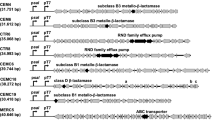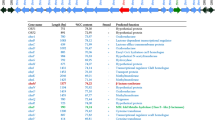Abstract
The β-lactams are the most widely used group of antibiotics in human health and agriculture, but this is under threat due to the persistent rise of pathogenic resistance. Several compounds, including tunicamycin (TUN), can enhance the antibacterial activity of the β-lactams to the extent of overcoming resistance, but the mammalian toxicity of TUN has precluded its use in this role. Selective hydrogenation of TUN produces modified compounds (TunR1 and TunR2), which retain the enhancement of β-lactams while having much lower mammalian toxicity. Here we show that TunR1 and TunR2 enhance the antibacterial activity of multiple β-lactam family members, including penems, cephems, and third-generation penicillins, to a similar extent as does the native TUN. Eleven of the β-lactams tested were enhanced from 2 to >256-fold against Bacillus subtilis, with comparable results against a penicillin G-resistant strain. The most significant enhancements were obtained with third-generation aminothiazolidyl cephems, including cefotaxime, ceftazidime, and cefquinome. These results support the potential of low toxicity tunicamycin analogs (TunR1 and TunR2) as clinically valid, synergistic enhancers for a broad group of β-lactam antibiotics.
Similar content being viewed by others
Log in or create a free account to read this content
Gain free access to this article, as well as selected content from this journal and more on nature.com
or
References
CDC Centers for Disease Control and Prevention. https://www.cdc.gov/drugresistance/
Ventola CL. The antibiotic resistance crisis: part 1: causes and threats. Pharm Ther 2015;40:277–83.
Bush K. Game changers: new β-lactamase inhibitor combinations targeting antibiotic resistance in Gram-negative bacteria. ACS Infect Dis. 2018;4:84–7.
Pasquina LW, Santa Maria JP, Walker S. Teichoic acid biosynthesis as an antibiotic target. Curr Opin Microbiol. 2013;16:531–7.
Sewell EW, Brown ED. Taking aim at wall teichoic acid synthesis: new biology and new leads for antibiotics. J Antibiot. 2014;67:43–51.
Labroli MA, Caldwell JP, Yang C, Lee SH, Wang H, Koseoglu S, et al. Discovery of potent wall teichoic acid early stage inhibitors. Discovery of potent wall teichoic acid early stage inhibitors. Bioorg Med Chem Lett. 2016;26:3999–4002.
Lee SH, Wang H, Labroli M, Koseoglu S, Zuck P, Mayhood T, et al. TarO-specific inhibitors of wall teichoic acid biosynthesis restore β-lactam efficacy against methicillin-resistant staphylococci. Sci Transl Med. 2016;8:329ra32.
Campbell J, Singh AK, Santa Maria JP, Kim Y, Brown S, Swoboda JG, et al. Synthetic lethal compound combinations reveal a fundamental connection between wall teichoic acid and peptidoglycan biosyntheses in Staphylococcus aureus. ACS Chem Biol. 2011;6:106–16.
Price NPJ, Hartman TM, Li J, Velpula KK, Naumann TA, Guda MR, et al. Modified tunicamycins with reduced eukaryotic toxicity that enhance the antibacterial activity of β-lactams. J Antibiot. 2017;70:1070–7.
Hancock IC, Wiseman G, Baddiley J. Biosynthesis of the unit that links teichoic acid to the bacterial wall: Inhibition by tunicamycin. FEBS Letts. 1976;69:75–80.
Kern J, Ryan C, Faull K, Schneewind O. Bacillus anthracis surface-layer proteins assemble by binding to the secondary cell wall polysaccharide in a manner that requires csaB and tagO. J Mol Biol. 2010;401:757–75.
Price NP, Momany FA. Modeling bacterial UDP-HexNAc: polyprenol-P HexNAc-1-P transferases. Glycobiology. 2005;15:29R–42R.
Al-Dabbagh B, Olatunji S, Crouvoisier M, El Ghachi M, Blanot D, Mengin-Lecreulx D, et al. Catalytic mechanism of MraY and WecA, two paralogues of the polyprenyl-phosphate N-acetylhexosamine 1-phosphate transferase superfamily. Biochimie. 2016;127:249–57.
Tamura G. Tunicamycins. Tokyo, Japan: Japan Scientific Press; 1982.
Price NPJ, Tsvetanova B. Biosynthesis of the tunicamycins: a review. J Antibiot. 2007;60:485–91.
Heifetz A, Keenan RW, Elbein AD. Mechanism of action of tunicamycin on the UDP-GlcNAc: dolichyl-phosphate GlcNAc-1-phosphate transferase. Biochemistry. 1979;18:2186–92.
Mclachlan KR, Krag SS. Substrate specificity of N-acetylglucosamine 1-phosphate transferase activity in chinese hamster ovary cells. Glycobiology. 1992;2:313–9.
Eckardt K. Tunicamycins, streptovirudins, and corynetoxins, a special subclass of nucleoside antibiotics. J Nat Prod. 1983;46:544–50.
Price NPJ, Labeda DP, Naumann TA, Vermillion KE, Bowman MJ, Berhow MA, et al. Quinovosamycins: New tunicamycin-type antibiotics in which the α, β-1′,11′-linked N-acetylglucosamine residue is replaced by N-acetylquinovosamine. J Antibiot. 2016;69:637–46.
Hering J, Dunevall E, Ek M, Brändén G. Structural basis for selective inhibition of antibacterial target MraY, a membrane-bound enzyme involved in peptidoglycan synthesis. Drug Discov Today. 2018;23:1426–35.
Brandish PE, Kimura K-I, Inukai M, Southgate R, Lonsdale JT, Bugg TDH. Modes of action of tunicamycin, liposidomycin B, and mureidomycin A: inhibition of phospho-N-acetylmuramyl-pentapeptide translocase from Escherichia coli. Antimicrob Agents Chemother. 1996;40:1640–4.
Xu L, Appell M, Kennedy S, Momany FA, Price NPJ. Conformational analysis of chirally deuterated tunicamycin as an active site probe of UDP-N-acetylhexosamine:polyprenol-P N-acetylhexosamine-1-P translocases. Biochemistry. 2004;43:13248–55.
Hakulinen JK, Hering J, Brändén G, Chen H, Snijder A, Ek M, et al. MraY-antibiotic complex reveals details of tunicamycin mode of action. Nat Chem Biol. 2017;13:265–7.
Chung BC, Zhao J, Gillespie RA, Kwon D-Y, Guan Z, Hong J, et al. Crystal structure of MraY, an essential membrane enzyme for bacterial cell wall synthesis. Science. 2013;341:1012–6.
Chung BC, Mashalidis EH, Tanino T, Kim M, Matsuda A, Hong J, et al. Structural insights into inhibition of lipid I production in bacterial cell wall synthesis. Nature. 2016;533:557–60.
Yoo J, Mashalidis EH, Kuk ACY, Ichikawa S, Lee S-Y. GlcNAc-1-P-transferase-tunicamycin complex structure reveals basis for inhibition of N-glycosylation. Nat Struct Mol Biol 2018;25:217–24.
Lukose V, Walvoort MTC, Imperiali B. Bacterial phosphoglycosyl transferases: initiators of glycan biosynthesis at the membrane interface. Glycobiology. 2017;27:820–33.
Jones MB, Rosenberg JN, Betenbaugh MJ, Krag SS. Structure and synthesis of polyisoprenoids used in N-glycosylation across the three domains of life. Biochim Biophys Acta. 2009;1790:485–94.
Cantagrel V, Lefeber DJ, Ng BG, Guan Z, Silhavy JL, Bielas SL, et al. SRD5A3 is required for converting polyprenol to dolichol and is mutated in a congenital glycosylation disorder. Cell. 2010;142:203–17.
Rolinson GN. The influence of 6-aminopenicillanic acid on antibiotic development. J Antimicrob Chemother. 1988;1988:5–14.
Elander RP. Industrial production of beta-lactam antibiotics. Appl Microbiol Biotechnol. 2003;61:385–92.
Petri Jr WA. Penicillins, cephalosporins, and other beta-lactam antibiotics. In: Brunton L Chabner, B Knollman, editors. Goodman and Gilman’s the pharmacological basis of therapeutics, (12th ed.). New York: McGraw Hill Professional; 2011. p. 1477–504.
Poirel L, Naas T, Le Thomas I, Amal K, Bingen E, Nordmann P. CTX-M-type extended-spectrum β-lactamase that hydrolyzes ceftazidime through a single amino acid substitution in the omega loop. Antimicrob Agents Chemother. 2001;45:3355–61.
Limbert M, Isert D, Klesel N, Markus A, Seeger K, Seibert G, et al. Antibacterial activities in vitro and in vivo and pharmacokinetics of cefquinome (HR llyV), a new broad-spectrum cephalosporin. Antimicrob Agents Chemother. 1991;35:14–9.
Tehrani KHME, Martin NI. β-lactam/β-lactamase inhibitor combinations: an update. Medchemcomm. 2018;17:1439–56.
Yang S-W, Pan J, Yang C, Labroli M, Pan W, Caldwell J, et al. Benzimidazole analogs as WTA biosynthesis inhibitors targeting methicillin resistant Staphylococcus aureus. Bioorg Med Chem Lett. 2016;26:4743–7.
Foxley MA, Wright SN, Lam AK, Friedline AW, Strange SJ, Xiao MT, et al. Targeting wall teichoic acid in situ with branched polyethylenimine potentiates β-lactam efficacy against MRSA. ACS Med Chem Lett. 2018;8:1083–8.
Wang H, Wang X, Ke ZJ, Comer AL, Xu M, Frank JA, et al. Tunicamycin-induced unfolded protein response in the developing mouse brain. Toxicol Appl Pharmacol. 2015;283:157–67.
Jago MV, Culvenor CC. Tunicamycin and corynetoxin poisoning in sheep. Aust Vet J. 1987;64:232–5.
Horikawa S, Ogawara H. Penicillin-binding proteins in Bacillus subtilis. The effects on penicillin-binding proteins and the antibacterial activities of beta-lactams. J Antibiot. 1980;33:614–9.
Sassine J, Xu M, Sidiq KR, Emmins R, Errington J, Daniel RA. Functional redundancy of division specific penicillin-binding proteins in Bacillus subtilis. Mol Microbiol. 2017;106:304–18.
Foster TJ. Can β-lactam antibiotics be resurrected to combat MRSA? Trends Microbiol. 2019;27:26–38.
Lages MC, Beilharz K, Morales Angeles D, Veening JW, Scheffers DJ. The localization of key Bacillus subtilis penicillin binding proteins during cell growth is determined by substrate availability. Environ Microbiol. 2013;15:3272–81.
Price NPJ, Jackson MA, Vermillion KE, Li J, Yu B. Selective catalytic hydrogenation of the N-acyl and uridyl double bonds in the tunicamycin family of protein N-glycosylation inhibitors. J Antibiot. 2017;70:1122–8.
Tsvetanova BC, Price NPJ. Liquid chromatography-electrospray mass spectrometry of tunicamycin-type antibiotics. Anal Biochem. 2001;289:147–56.
Dowd PF, Berhow MA, Johnson ET. Differential activity of multiple saponins against omnivorous insects with varying feeding preferences. J Chem Ecol. 2011;37:443–9.
Singh V, Brecik M, Mukherjee R, Evans JC, Svetlikova Z, Blasko J, et al. The complex mechanism of antimycobacterial action of 5-fluorouracil. Chem Biol. 2015;22:63–75.
Singh V, Donini S, Pacitto A, Sala C, Hartkoorn RC, Dhar N, et al. The inosine monophosphate dehydrogenase, GuaB2, is a vulnerable new bactericidal drug target for tuberculosis. ACS Infect Dis. 2017;3:5–17.
Odds FC. Synergy, antagonism, and what the chequerboard puts between them. J Antimicrob Chemother. 2003;52:1.
Acknowledgements
We thank David Lee for technical assistance and Dr Christopher Skory for pre-review of the manuscript. VS acknowledges the South African Medical Research Council (SAMRC) for funding. Mention of any trade names or commercial products is solely for the purpose of providing specific information and does not imply recommendation or endorsement by the US Department of Agriculture. USDA is an equal opportunity provider and employer.
Author information
Authors and Affiliations
Contributions
NPJP, MAJ, PFD and VS designed research; NPJP, MAJ, VS, PFD, TMH and JAB performed research; NPJP, MAJ, and VS analyzed the data; and NPJP, MAJ, VS, PFD and TMH wrote the paper.
Corresponding author
Ethics declarations
Conflict of interest
The authors declare that they have no conflict of interest.
Additional information
Publisher’s note: Springer Nature remains neutral with regard to jurisdictional claims in published maps and institutional affiliations.
Supplementary information
Rights and permissions
About this article
Cite this article
Price, N.P.J., Jackson, M.A., Singh, V. et al. Synergistic enhancement of beta-lactam antibiotics by modified tunicamycin analogs TunR1 and TunR2. J Antibiot 72, 807–815 (2019). https://doi.org/10.1038/s41429-019-0220-x
Received:
Revised:
Accepted:
Published:
Issue date:
DOI: https://doi.org/10.1038/s41429-019-0220-x
This article is cited by
-
The tunicamycin derivative TunR2 exhibits potent antibiotic properties with low toxicity in an in vivo Mycobacterium marinum-zebrafish TB infection model
The Journal of Antibiotics (2024)
-
Antibiotics: From Mechanism of Action to Resistance and Beyond
Indian Journal of Microbiology (2024)



